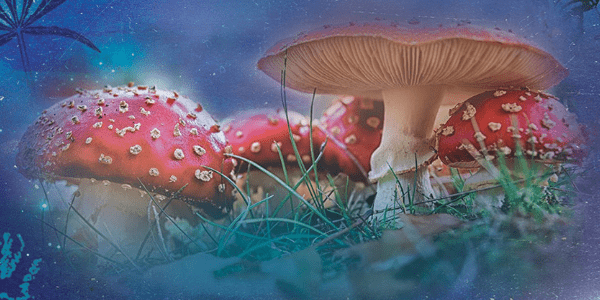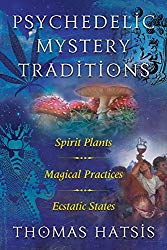
Psychedelic Mystery Traditions: Spirit Plants, Magical Practices, and Ecstatic States, by Thomas Hatsis
Park Street Press, 9781620558003, 288 pp., 2018
In Psychedelic Mystery Traditions: Spirit Plants, Magical Practices, and Ecstatic States, Thomas Hatsis draws a line from pre-history through the modern age, arguing that humans have always sought to alter their consciousnesses using pharmka in service of exploring the sacred and in seeking divinity.
Hatsis walks the reader through various historical periods, discussing archaeological and mythological clues and cues that suggest for thousands of years and across continents, people have sought out compounds that could be ingested to permit psychic exploration. I think most occultists would acknowledge altering consciousness can be a part of ritual practice, or be used as a way to make a day seem more magical. There is a long history of human experimentation with pharmaka for mystical or psychic expansion.1 Hatsis does great work in compiling evidence to support the claim that psychedelic mystery traditions are as old as human history.
This is an ambitious book. The introduction by writer and teacher Stephen Gray orients the reader to the project Hatsis has undertaken. Grey writes, “The great and universal “open secret” is that […] we are not separate — not separate from the living Earth, from each other, and from the eternal creative intelligence.”2 The thread that Gray identifies here, which makes Hatsis’ broad sweeping historical account legible, is that the use of pharmaka is an important and traditional tool in the human search for meaning, connection, and divinity. Although I found this book difficult at times — there’s a lot of historical information to wade through — it was successful in that it establishes that psychedelics are, and always have been, legitimate tools for us to access an experience of the divine.
Hatsis starts off by explaining his terms and the objectives of the work. He introduces the reader to a series of neologisms to describe psychedelics, including his own etymology for many. Examples include “theogens” (a substance that assists to generate divinity), “poetigens” (substance that unlocks creativity), and “mystheogens” (substance that serves to assist one to enter a mystery religion). I understand the rationale behind his inclusion of these terms in order to help the reader see psychedelics as something akin to keys that can unlock very specific sacred doors. Unfortunately, this type of whimsy falls flat and makes me impatient.
Hatsis uses three approaches to his subject: literary and historical fiction to set the stage, discussion of archaeological artifacts that contain representations of pharmaka, and finally, discussion of the historical evidence. We begin with pre-history to ancient Greece and Rome. He begins in the Bubalus stage (circa 10,000-8000 BCE) and then identifies the Round Head Period (circa 8000-6000 BCE), where there appears to be the first artistic representation of mushrooms in a cave drawing. However, I’m not convinced about how much meaning we can ascribe to the depiction of mushrooms here. Hatsis uses the phrase “Neolithic psychenaut” to suggest prehistoric people were apt to trip on psychedelics. (He uses the term “psychenaut” to describe anyone engaged in psychic exploration, especially via psychedelic pharmka.) I’m leery of making too many inferences about the nature or purpose of prehistoric mushroom imbibing.
By the time he turns his attention to the ancient Greeks, I feel like Hatsis is on more solid historical footing, simply because we have a greater understanding of that period. Hatsis discusses mushrooms and ergots, which are found in barley, as well as other grains and grasses. He addresses scholarly controversies regarding which psychedelic compounds the ancient Greeks would have been capable of synthesizing, considering the technology of the time.
In the second part of the book, he covers ancient Gnosticism and ancient Christianity. This section was challenging, because Hatsis gets into the weeds of the Old Testament, especially Matthew and 2 Esdras (an apocalyptic book of the Bible). Here, he begins to cite passages that may reference mandrake and mushrooms in order to determine the veracity of claims regarding their use as entheogens. This isn’t a superficial reading of texts — it’s a deep dive. Frankly, I found this section challenging to understand. I’d speculate that if readers aren’t theologians or academics of Nazarene history, they might also struggle.
Finally, the third part of Psychedelic Mystery Traditions is my favourite, as it covers Renaissance witchcraft and magick. Hatsis includes a discussion of goddess religions here, backtracking to cover material as old as 10,000 BCE, before moving through the witch hunts of 15th and 16th centuries. I enjoyed reading about what he termed “Renaissance psychenauts” and their use of flying ointments — topics that anyone familiar with the history of European witchcraft may enjoy learning more about from a psychedelic perspective.
Hatsis switches styles in each section, which makes for a difficult read. For example, he begins describing the 5000 BCE through 500 CE eras with a narrative about a man, Coretas, founding the ancient city of Delphi. He uses narrative to draw the reader into imagining how psychedelic use may have happened in this period. He then goes on to discuss the relevant artifacts from the time that, according to archaeologically retrieved artwork, suggests a pre-historical familiarity with psychedelic pharmacology. The effect is poetic and lyrical, but it’s not a style I’m personally fond of. I may suffer from an imaginative impairment, but I prefer my nonfiction to be free of speculative historical fiction.
Style aside, it’s hard to ignore Hatsis’ scholarship. Hatsis has done an impeccably thorough job gleaning evidence, and the range of history he spans is ambitious: from 10,000 BCE to the Victorian age in the early 20th century. At the end of the book, there are extensive notes, an expansive bibliography, and a thorough index.
I did find myself wondering whether Hatsis’ positionality as a Western researcher in the 21st century had narrowed the lens through which we view first peoples’ relationship to divinity. Psychedelics and mind altering drugs (including alcohol) can offer people a fascinating way to view the world. At the same time, as much as archaeology and anthropology can reveal about the way ancient people lived, it’s difficult to access their actual experiences. I tend to think that ancient people, in the absence of scientific explanations, might have had radically different forms of thinking, imagining, and worshipping. If cultures tended toward religious explanations for the world around them, I can imagine this would lend itself to a very rich experience of the natural world — an experience that we might struggle to comprehend in our current state of post-industrial scientific capitalism, where our worldview tends to be mechanistic and reductionist. This contemplation of how ancient civilization might worship using pharmaka might betray a certain modern hubris, or a lack of imagination to accept that our forebears had experiences of divinity that today we would struggle to understand.
Hatsis limits his analysis to western cultures, which localizes his work culturally and avoids a colonialist perspective for the most part. At the same time, a reader of this book learns nothing about indigenous North Americans, who of course had their own pathways to divinity, which may have (or may still) incorporate psychedelic pharmaka.
Overall, this is broad ranging book that veers towards unwieldiness at times. Perhaps that’s why I struggled with the style when Hatsis lapsed into storytelling mode. I already felt a little disoriented by the sheer span of the book, and adding the elements of fiction made it less intelligible to me, rather than more relatable.
Despite my criticisms, I admire the scope and objectives of Psychedelic Mystery Traditions: to ground the use of psychedelics in mystic tradition from the birth of known history through to today. It’s ambitious and, for the most part, I think Hatsis pulled it off. I’d love to see a work about how pharmaka tracks through non-western spiritual traditions, for I do think there would have been room here to acknowledge indigenous cultures in North America.
- It’s worth noting that I’m not writing exclusively about the use of psychedelics here, which many look upon as a shortcut to expanded or altered consciousness. [↩]
- p. x [↩]









